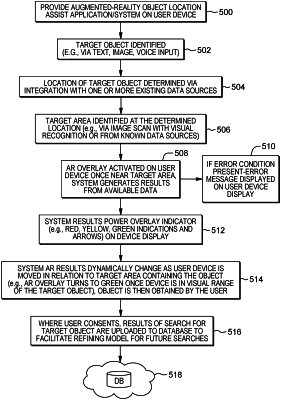| CPC G06V 20/20 (2022.01) [G06Q 30/0639 (2013.01); G06T 7/50 (2017.01); G06T 19/006 (2013.01); G06V 10/25 (2022.01); G06T 2207/20081 (2013.01)] | 9 Claims |

|
1. A computer program product for providing augmented-reality object location assistance, the computer program product comprising:
one or more computer-readable storage media having program instructions embodied therewith, the program instructions being readable by a processing circuit to cause the processing circuit to perform a method comprising:
obtaining a user-request, the user-request being related to facilitating locating an object of interest;
identifying a target area containing the object of interest;
providing augmentation data for rendering as an overlay on a user-device to assist in directing the user to the target area containing the object of interest; and
dynamically changing the augmentation data being provided for rendering as the overlay as the user-device is moved in relation to the target area containing the object of interest to assist the user in locating the object of interest within the target area;
determining, based on identifiable attributes of multiple specified attributes of the object of interest and historical data from past searches of the object of interest, a first probability score related to location of the object of interest; and
determining, using machine learning, a second probability score of whether the object is within a visible range of a camera of the user-device, wherein a value of the second probability score being closer to zero indicates the object being farther away from the camera, and a value of the second probability score being closer to one indicates the object being closer to the camera,
the first probability score and the second probability score being used in providing the augmentation data for rendering as the overlay on the user-device.
|